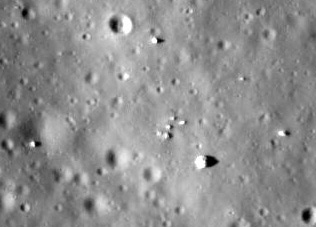Of historical interest to some, and imaged
three times by LRO perhaps because of this interest, here are the
so-called Blair Cuspids which gained some notoriety in the late
60's.
Attached is a cropped version of the original Lunar Orbiter II
image (61H3). The Sun elevation is 11 degrees. The shadow
length (using LRO data to measure the distance between the surface
features) of the widest object is about 113 meters.
The location based on LRO coordinates seems to be 5.024 degrees N
latitude and 15.58 degrees E longitude.
The LRO image (http://wms.lroc.asu.edu/lroc/view_lroc/LRO-L-LROC-3-CDR-V1.0/M159847595RC)
shows the site at 1755 pixels from the left and 23760 pixels from
the top (perform a 180 degree rotation to get the site oriented
correctly). The Sun elevation is 42 degrees and the slew
angle near zero with a pixel resolution widthwise of 0.4
m/pixel. A cropped/rotated version is attached.
The LRO image (http://wms.lroc.asu.edu/lroc/view_lroc/LRO-L-LROC-3-CDR-V1.0/M181066153RC
) shows the site at 3120 pixels from the left and 741 pixels from
the top (perform a flip about the horizontal axis.. up/down are
flipped to get the site oriented correctly). The Sun
elevation is 23 degrees and the slew angle near zero with a pixel
resolution widthwise of 1.14 m/pixel. A
cropped/flipped version is attached.

The LRO image (http://wms.lroc.asu.edu/lroc/view_lroc/LRO-L-LROC-3-CDR-V1.0/M192853500LC
) shows the site at 3402 pixels from the left and 16903 pixels
from the top (perform a 180 degree rotation to get the site
oriented correctly). The Sun elevation is 20 degrees and the
slew angle near zero with a pixel resolution widthwise of
1.12 m/pixel. A cropped/rotated version is attached.
Because we have images at different Sun angles, it is possible to
determine the surface slope near the objects. The two most
recent LRO images have Sun coming from opposite directions and at
similar elevation but clearly the shadow lengths are
different. Using trig, it turns out that -3.85 degrees in
the Westward direction explains the different shadow
lengths. This implies the height of widest one to be 10.3 m
(since the widthwise 0.4m/pixel by heightwise 0.55m/pixel M159*
image shows it to be about 11 m on the other two sides, this makes
sense). However, using this height provides only a shadow of
83 m long for it. Examining M192* shows that perhaps the
slope falls away even more beyond the nearby proximity of the
widest object. Only 1.9 extra degrees is required to get the
observed shadow length of 113 m.





